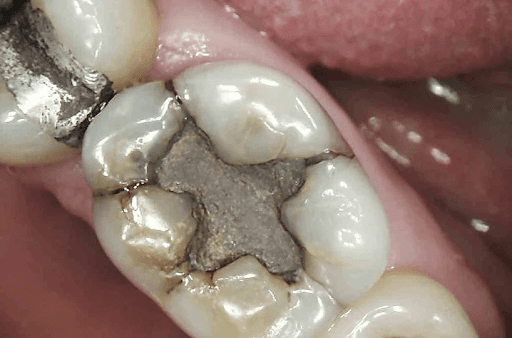Metal fillings
For many years, the filling of dental cavities has commonly been done with metallic materials also known as dental amalgams.
Due to the wear or aging of these materials, their removal may be recommended.
It is then important to follow a rigorous treatment plan to protect the patient’s body from contact with potentially harmful metals such as mercury or nickel, for example.
This treatment plan must be personalized based on the type, number, and size of the defective fillings as well as the physiological condition of the patient.
He employs rigorous protective measures for the patient and the practitioner.
In general, by enhancing the immune system using, for example, dietary supplements as recommended by the European Food Safety Authority (EFSA Journal 2010; 8(2):1489) before, during, and after the removal, and by using protective gear (glasses, suits, …)
Locally, by establishing operative fields (dam), efficient peripheral suction, using new specific drills for the removal, through fractionation and not wear of old restorations
All this in a ventilated and continuously aired room.
It is during a specific individual clinical observation that these treatments, their chronology, and any prescriptions are chosen.
After healing, new non-metal materials ensure, sustainably, the reconstruction of these cavities.
For information
The “fillings” are amalgams of different metals that have been used for over a century. It is a mixture of mercury, copper, silver, and tin. Contrary to its name, it does not contain lead.
The oral cavity represents a very aggressive environment both mechanically and chemically, and this alloy of different metals corrodes over time. The amalgam degrades, loses its mechanical and biological properties, and a recurrence of cavities may occur.
The amalgam restorations release tiny amounts of mercury vapor, especially during chewing, and the body can absorb some of this mercury, which can affect various organs.

This corrosion is stronger and faster if different metals already exist in the mouth, creating measurable electric currents (galvanic).
The oral galvanic effects can thus have harmful consequences :
on a local level : sensation of electric current, burning sensations, appearance of gum tattoos, …
on a locoregional level : headaches, facial muscle contractions, hives, allergic syndromes (chronic sinusitis, asthma, …), tinnitus, …
on a general level : chronic fatigue, headaches, irritability, depression, kidney problems, electro-sensitivity, chemo-sensitivity, …
